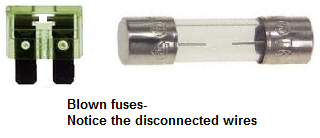

The vehicle owner’s manual will provide details on where the fuse box is located in a car. Locations of fuse boxes in vehicles may vary. A fuse may have blown in your vehicle if you are struggling to start your vehicle, are no longer able to operate your headlights, windshield wipers, interior lights, radio, or other electrical components. On occasion though, the current may be too much for even the fuse causing it to blow. Fuses stabilize currents, allowing the mechanism to function seamlessly. A large current to any electrical mechanism will cause instant failure. If your vehicle was not equipped with fuses, an overloaded electrical current could cause wiring to overheat, melting the insulation, and could cause a fire. Car fuse box service may be required when your car experiences troubles with one or more electrical components. Any time multiple fuses blow, it’s likely the fuse box is experiencing some sort of difficulty. While you may suspect your battery or alternator is responsible for a loss in electrical mechanisms, it’s entirely possible a blown fuse is the cause.
BLOWN FUSE DRIVERS
Drivers may experience difficulties with the radio, dome lights, and other electrical components within the vehicle when fuses are blown. Fuses are made to control and safeguard electrical currents that flow through wires to electrical components.

Replacing a fuse is easier than replacing a whole wire, but is there a way to get around it entirely? Now that we have a little background, let's find out if there's any truth to the gum gossip.Fuse boxes are made to protect electrical circuits in the car from exposure to the elements preventing damage and short circuits. Circuit breakers are generally the norm in houses today, although some older homes may still have fuses. Circuit breakers on the other hand, are easier to reset since they simply switch off rather than melt a wire, but they tend to be more expensive. For example, fuses are cheap, but they're also limited to onetime use, so they may need to be replaced frequently. While circuit breakers build on fuse technology, pros and cons remain for both methods of preventing electrical overloads. For more information on the protective electrical veins that run through mechanical devices and the critical junctions that connect them, read How Wires, Fuses and Connectors Work.Ĭircuit breakers are similar to fuses and perform the same basic function. If the current flowing through a wire gets too hot, it could start a fire, so it's important to use a fuse with the correct amp rating. It interrupts the current by melting and breaking the connection.įuses commonly are categorized by how much amperage (amount of electrical current) the fuse can handle. This way, if an electrical current is approaching a temperature that's too hot for the wire to handle, the fuse will be the first to know. In the middle of the fuse's fireproof protective casing is a conductive metal with a specific melting point - one that's a lower temperature than the wire's. A fuse generally has two metal prongs that make contact with the wire on either side. What they all have in common is the capacity to keep wire from overheating. Fuses have been around since the 1800s and come in various shapes and sizes.

But first, let's take a closer look at those pesky but protective little plugs. In this article, we'll look into whether there's any truth to the rumor that a chewing gum wrapper can provide an ingenious fix for a blown fuse. But does blowing a fuse automatically mean a trip to an auto parts or hardware store? A blown fuse can mean a bad day, especially if it's a component of some critical electrical system, like your car's horn during rush hour.


 0 kommentar(er)
0 kommentar(er)
